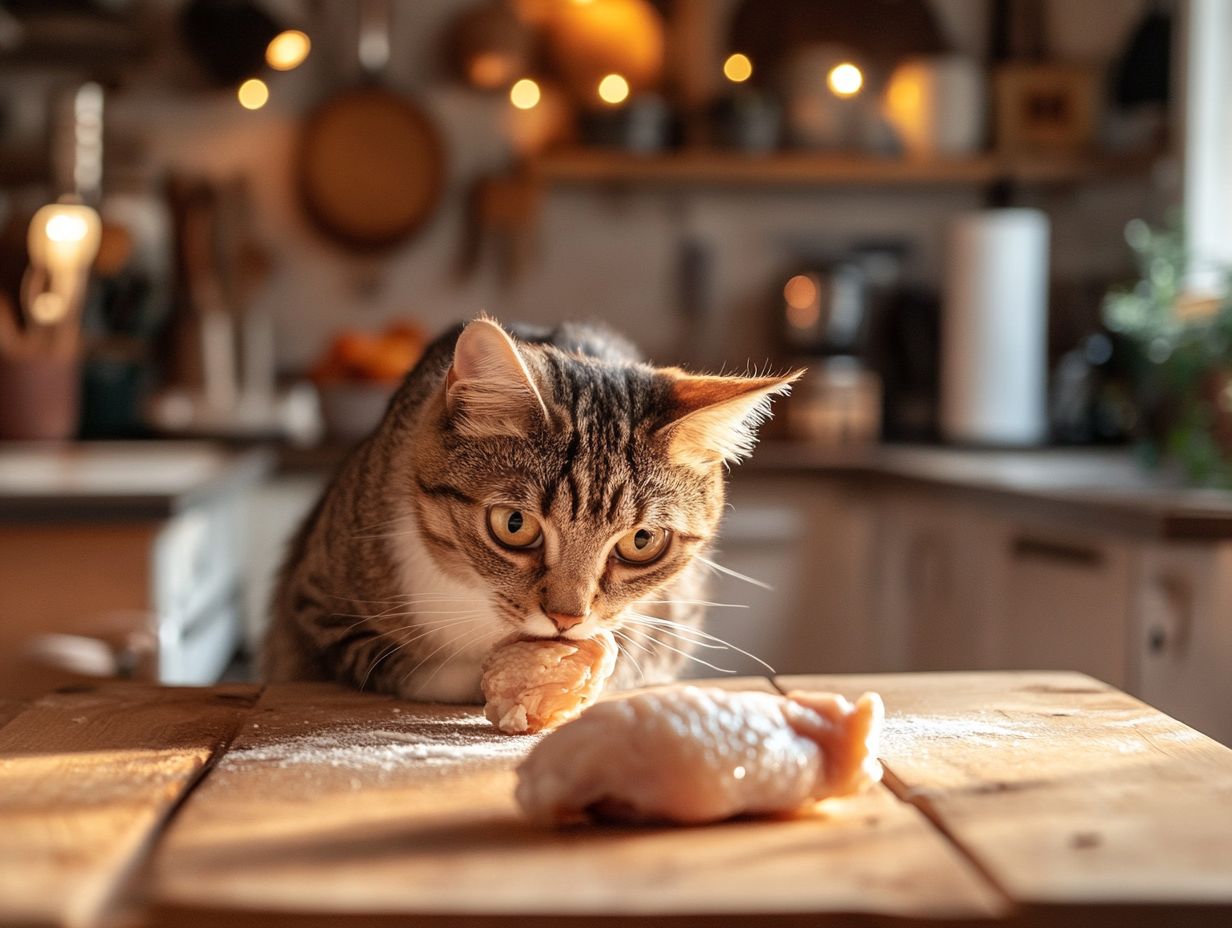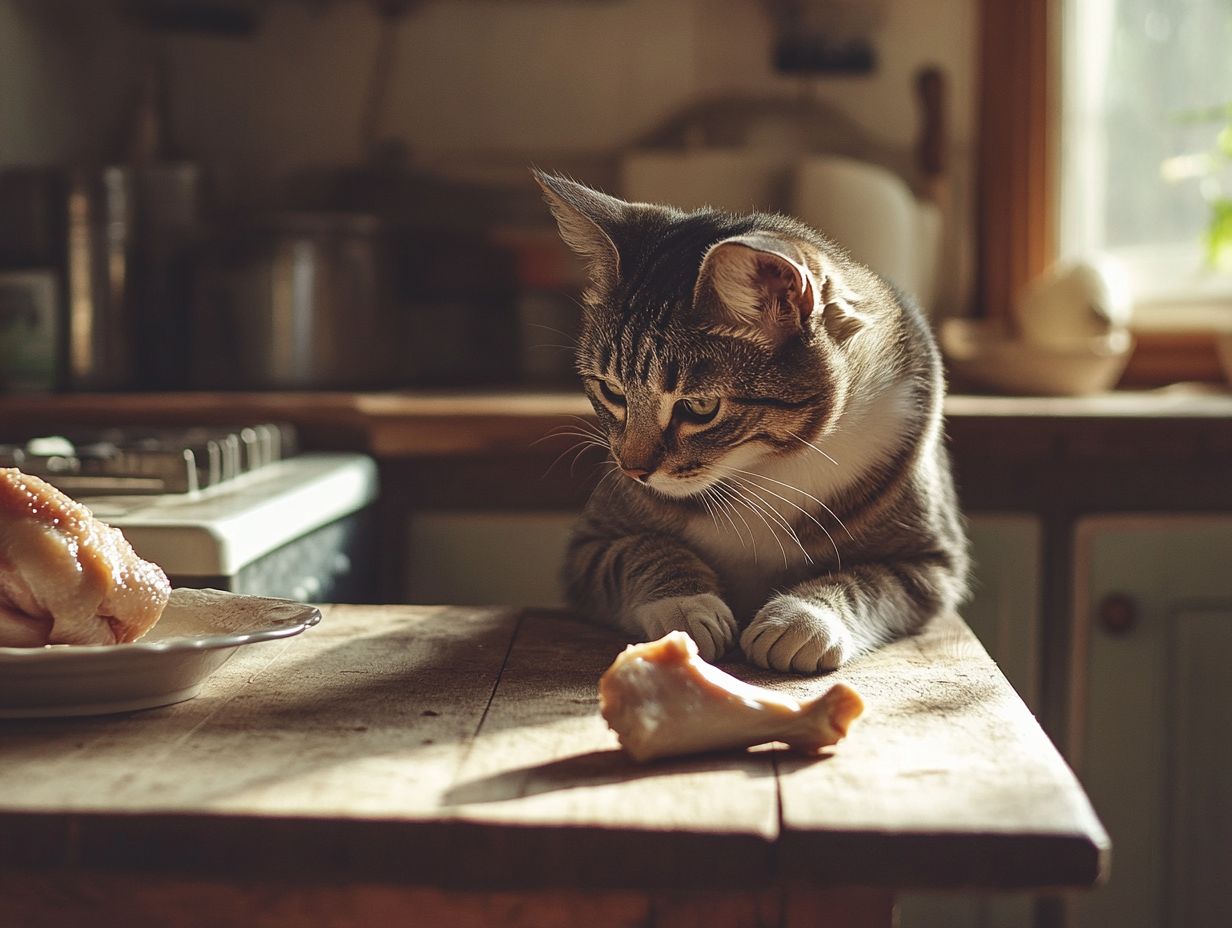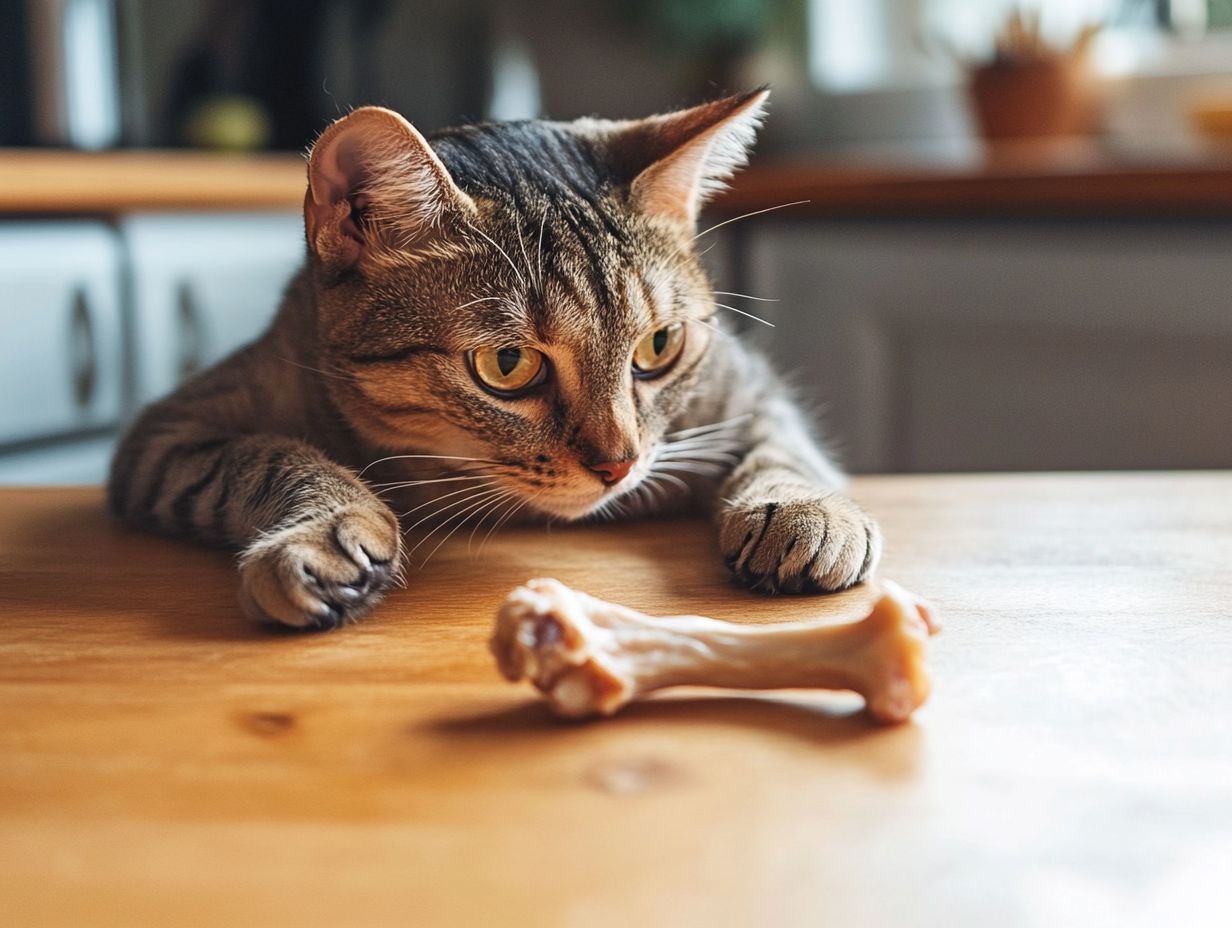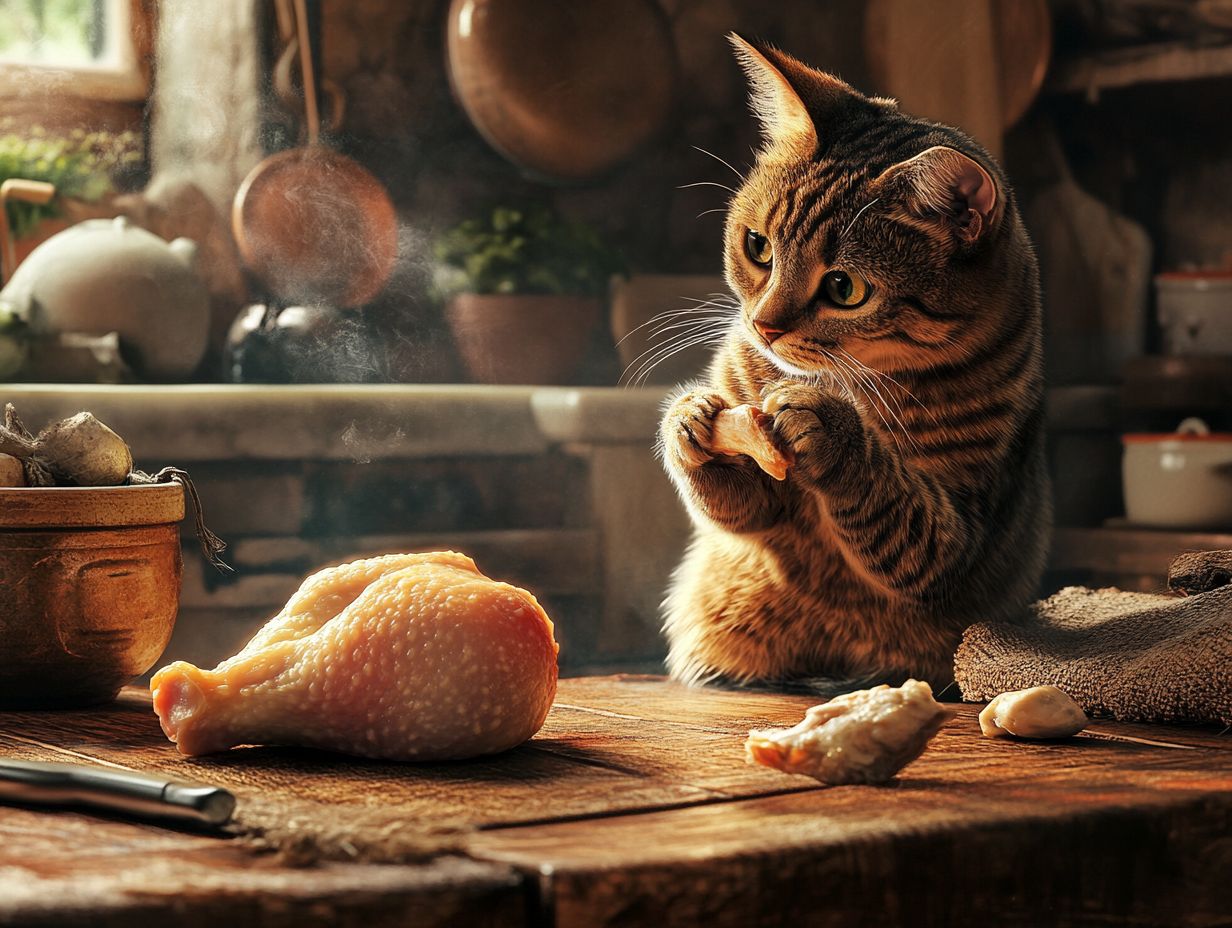This article addresses whether chicken bones are safe for your cat and the considerations for feeding them. You might wonder about the safety, nutritional benefits, and potential health hazards of this common food item.
We will explore the different types of chicken bones, distinguishing between those that are safe and those that pose risks, like bone fragments and bone shards. The article will also discuss potential health consequences such as GI-related issues, provide alternative feeding options, and offer guidelines for safely incorporating chicken bones into your cat’s diet, if suitable.
Join us as we uncover the facts and help you make informed choices for your kitty’s health!
Key Takeaways:

- Feeding cats chicken bones is a controversial topic, with risks and benefits to consider.
- Not all chicken bones are safe for cats to consume—avoid small and cooked bones.
- If you choose to feed your cat raw chicken bones, offer them in moderation—about one to two bones per week depending on your cat’s size.
- Always consult your veterinarian for tailored dietary choices.
Can Cats Eat Chicken Bones?
The question of whether cats can eat chicken bones remains a topic of heated debate among cat owners and veterinarians. As carnivorous animals that primarily eat meat, the type of bones—raw or cooked—can significantly impact their health, especially in terms of nutritional benefits and potential health hazards like dangerous bacteria.
While some pet owners may view chicken bones as a way to enhance their cat’s diet, it is essential to weigh the associated risks and nutritional drawbacks. Notably, the distinction between raw and cooked chicken bones is crucial, as cooked bones can splinter and pose serious health hazards, such as choking, gastrointestinal blockages, and other digestive problems.
The Debate on Feeding Cats Bones
The debate over whether to feed cats bones is contentious among veterinarians and pet owners. On one hand, advocates argue that raw bones are a vital component of a balanced feline diet, offering essential nutrients and promoting dental health by helping to remove plaque and tartar buildup. They often refer to the natural diets of wild and undomesticated cats, suggesting that these nutritional practices can enhance the overall well-being of domesticated cats and meet their dietary needs.
For more information, you can read about whether cats can eat chicken bones in this article: Can Cats Eat Chicken Bones? Are They Safe?
On the other hand, opponents highlight the significant dangers that bones can pose to cats. Common risks include choking hazards, as well as potential gastrointestinal (GI) blockages and tears, particularly with cooked bones. Many veterinarians emphasize that each cat has unique health requirements, noting that while some cats may thrive on diets that include bones, others may suffer negative consequences, such as nutrient deficiencies and other dietary risks.
Types of Chicken Bones
Chicken bones for cats can be classified as either raw or cooked. This distinction is crucial because raw chicken bones are soft and pliable, aiding in proper digestion and supporting the digestive system. In contrast, cooked chicken bones tend to splinter and pose serious risks to cats, including choking, gastrointestinal blockage, and food poisoning, which can potentially be fatal.
Identifying Safe and Unsafe Bones

Identifying safe and unsafe bones is essential for pet owners who wish to feed chicken to their cats without risking their health. Veterinarians warn that there is no single type of bone that is universally safe, as some bones can splinter, cause serious internal injuries, or lead to bloating and other GI-related issues.
Raw chicken necks and wings are generally considered safe, as they provide nutritional value and can help clean teeth, contributing to overall cat health. However, cooked bones of any kind should always be avoided, as cooking makes bones brittle and sharp, leading to potential bone shards. Additionally, large bones, such as those from turkey or beef, should also be avoided due to the risk of choking and the potential to fracture teeth.
Always supervise your cat while they are eating bones to prevent choking. For tailored dietary choices, consult your veterinarian to meet your cat’s specific health needs.
In summary, raw chicken bones can be a nutritious treat for cats when fed safely and in moderation, but cooked bones should always be avoided to prevent serious health risks.
Can cats eat chicken bones? The short answer is no; feeding cats chicken bones poses significant risks to their health and safety. A veterinarian can assist pet owners in developing a feeding schedule that allows their feline friends to enjoy occasional treats while ensuring their safety.
Potential Risks of Feeding Cats Chicken Bones
Cat owners should be aware of the potential risks associated with feeding their pets chicken bones to ensure their health and safety. The dangers of feeding raw chicken bones are typically less severe than those posed by cooked chicken bones, which can splinter due to the cooking process and lead to choking, gastrointestinal blockages, and other digestive tract issues.
Additionally, there are significant health risks related to foodborne illnesses, such as salmonella and Campylobacter, that can affect both cats and humans. It is important for owners to recognize the symptoms of these dangers so they can respond appropriately if necessary, adhering to proper food safety protocols.
Possible Health Consequences
Feeding cats chicken bones poses various health risks, ranging from mild digestive upset to serious gastrointestinal issues that may necessitate veterinary intervention. One of the primary dangers is that chicken bones can splinter and become lodged in, or cut, the digestive tract if swallowed, leading to severe health complications.
Common signs of distress include:
- Vomiting
- Diarrhea
- Abdominal discomfort
- Bloating
- Lethargy
It is essential to observe the cat for several hours after it consumes bones; changes in bowel movements may require an emergency visit to the veterinarian. For more information, check out this article on Can Cats Eat Chicken Bones? Are They Safe?.
Regular veterinary checkups play a vital role in ensuring your cat’s overall health and can help prevent and address any complications arising from bone consumption. Consulting veterinary advice ensures a vet-approved diet and guidance on feeding guidelines.
Alternatives to Feeding Cats Chicken Bones
You can provide your cats with several chicken alternatives that are nutritious, safe, and designed to meet their dietary needs, without the risks associated with human food additives like garlic powder or onion powder. For more information on whether cats can eat chicken bones, check out Can Cats Eat Chicken Bones? Are They Safe?.
- Commercial Chicken Treats: Many commercial cat treats come in chicken flavors, offering a similar taste and aroma to real chicken while avoiding harmful ingredients. These treats are specifically formulated to be safe for cats and can be used as a supplement to their regular diet.
- Homemade Chicken Broth or Stock: Homemade or commercial chicken broth serves as a nutritious alternative to raw or cooked chicken. However, it should not contain salt or other harmful seasonings such as garlic powder or onion powder. Broth can be added to your cat’s water for flavor enhancement, poured over standard cat food, or served on its own. It’s important to note that chicken broth is not a complete meal replacement but rather a nutritional supplement. Appropriate portion size is about 1-2 tablespoons for cats weighing up to 10 lbs.
- Cooked Chicken Liver: Chicken liver is an excellent source of protein, vitamins, and minerals. Available fresh or frozen, it can be prepared by boiling or sautéing. Cooked chicken liver is generally offered as a supplement rather than as a full meal. Recommended portion is about 1 tablespoon for cats weighing up to 10 lbs.
- Chicken Bouillon: Chicken bouillon can provide flavor and some nutrients, but it often contains high sodium levels. When fed in moderation and especially diluted in water (1 part bouillon to 4 parts water), it can be part of a safe and nutritious diet.
- Commercial Cat Food: Although not chicken-based, various types of commercial wet or dry cat food offer similar nutritional benefits. While these alternatives may not perfectly replicate chicken, they can help satisfy a cat’s dietary requirements without the risks associated with consuming chicken.
Safe and Nutritious Alternatives

Safe and nutritious alternatives to chicken bones, such as chicken treats and chicken broth, provide satisfying options for cats without the associated risks of bone consumption. Additionally, shredded cooked chicken and fish, like salmon or tuna, can serve as delicious, protein-packed snacks that support proper digestion and cat nutrition. However, be mindful of potential allergies cats might have to chicken or fish, and consult your vet when introducing new foods.
Actionable Tips: If a cat has ingested chicken bones, monitor for symptoms of distress and contact your veterinarian immediately if any signs appear. Quick action can help ensure your pet receives the care it needs.
Ensuring the safety and nutritional health of your cat is paramount. Various preparation methods can be used for cat-friendly meals, but simply boiling or baking the meat without any seasoning guarantees it remains safe for cats. Canned pumpkin is also an excellent option, providing fiber that promotes digestive health, complementing protein sources while meeting their dietary needs.
These alternatives not only satisfy a cat’s nutritional requirements but also keep mealtime interesting. Always check that any treats given are appropriately portioned to maintain balance within their overall diet—ideally, no more than 10% of their daily caloric intake.
Benefits of Safe Feeding Practices
Feeding cats safe food options like boiled or baked chicken provides essential proteins without risks associated with bones. These methods help maintain their health and prevent gastrointestinal issues.
Risks of Feeding Chicken Bones
Feeding cats chicken bones safely requires careful consideration. It is crucial to be aware of the potential health risks, especially regarding raw and cooked chicken bones, as each type necessitates different feeding practices. Cooked chicken bones should be strictly avoided due to their propensity to splinter, leading to serious health problems.
Precautions and Guidelines
To minimize the risk of adverse health effects, ensure that the bones are always raw rather than cooked. Cooked bones can become brittle and increase the likelihood of splintering. Monitor your cat’s health after introducing any new food. Keeping a food diary can help track their reactions; any signs of distress, such as vomiting, bloating, or changes in behavior, should prompt immediate consultation with a veterinarian.
Collaborating with a veterinarian to develop an appropriate feeding regimen tailored to your cat’s unique dietary needs is invaluable in preventing potential health issues and gastrointestinal problems. A vet-approved diet helps ensure proper digestion and overall cat health.
Frequently Asked Questions
Can Cats Eat Chicken Bones?

It is generally not recommended for cats to eat chicken bones. While they are obligate carnivores requiring a diet primarily composed of meat, chicken bones pose potential risks such as damaging their digestive tract.
Are Chicken Bones Safe for Cats to Eat?
No, chicken bones are not safe for cats. Cooked bones can splinter and cause serious damage to a cat’s mouth, throat, and gastrointestinal tract, leading to severe digestive problems.
What Should I Do if My Cat Accidentally Eats a Chicken Bone?
If your cat accidentally consumes a chicken bone, monitor them closely for signs of distress, such as vomiting, diarrhea, bloating, or difficulty breathing. If any concerning symptoms arise, contact your veterinarian immediately to prevent gastrointestinal blockage and other issues.
Why Are Chicken Bones Dangerous for Cats?
Chicken bones can be dangerous due to their small size and ability to splinter, which may cause punctures, choking, or blockages in a cat’s digestive tract, potentially leading to severe health complications.
Can Cats Eat Raw Chicken Bones?
No, cats should not be fed raw chicken bones. Although they are less likely to splinter than cooked bones, they still pose a choking hazard and may carry dangerous bacteria like Salmonella and Campylobacter.
What Can I Feed My Cat Instead of Chicken Bones?
Cats can obtain all necessary nutrients from a balanced diet of high-quality commercial cat food. For extra protein, consider offering cooked, boneless chicken or chicken broth, ensuring no harmful ingredients like garlic or onion powder are included.
Conclusion
Safe feeding practices are crucial for maintaining your cat’s health. Always consult your veterinarian for personalized advice tailored to your cat’s unique dietary needs. By being mindful of meal preparation and monitoring your cat’s reactions, you can ensure a happy and healthy feline companion.